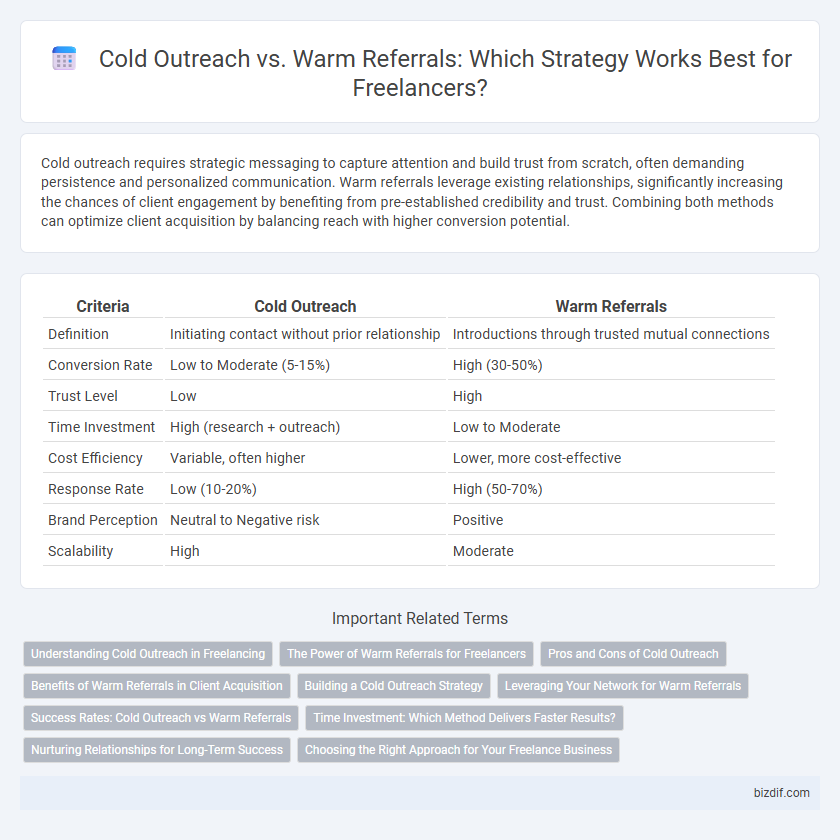Cold outreach requires strategic messaging to capture attention and build trust from scratch, often demanding persistence and personalized communication. Warm referrals leverage existing relationships, significantly increasing the chances of client engagement by benefiting from pre-established credibility and trust. Combining both methods can optimize client acquisition by balancing reach with higher conversion potential.
Table of Comparison
| Criteria | Cold Outreach | Warm Referrals |
|---|---|---|
| Definition | Initiating contact without prior relationship | Introductions through trusted mutual connections |
| Conversion Rate | Low to Moderate (5-15%) | High (30-50%) |
| Trust Level | Low | High |
| Time Investment | High (research + outreach) | Low to Moderate |
| Cost Efficiency | Variable, often higher | Lower, more cost-effective |
| Response Rate | Low (10-20%) | High (50-70%) |
| Brand Perception | Neutral to Negative risk | Positive |
| Scalability | High | Moderate |
Understanding Cold Outreach in Freelancing
Cold outreach in freelancing involves contacting potential clients without prior interaction, relying on personalized and strategic messaging to capture attention. Effective cold outreach requires research on client needs, crafting clear value propositions, and following up consistently to build credibility. While challenging, mastering cold outreach expands a freelancer's network and opens opportunities beyond existing connections.
The Power of Warm Referrals for Freelancers
Warm referrals generate higher conversion rates for freelancers by leveraging existing client trust and personal connections. Unlike cold outreach, which often results in low response rates and requires extensive follow-up, warm referrals provide pre-qualified leads and faster onboarding. Studies show freelancers who consistently utilize warm referrals experience increased project frequency and improved client retention.
Pros and Cons of Cold Outreach
Cold outreach enables freelancers to expand their client base by proactively contacting potential clients, offering greater control over lead generation and access to untapped markets. However, it often yields lower response rates and can appear intrusive, requiring personalized messaging and perseverance to establish trust. Despite these challenges, cold outreach remains a cost-effective strategy to create new opportunities beyond the freelancer's immediate network.
Benefits of Warm Referrals in Client Acquisition
Warm referrals in freelancing generate higher trust and credibility, leading to a significantly increased client conversion rate compared to cold outreach. Clients referred by mutual contacts typically have clearer project expectations and are more likely to engage in long-term collaborations. This targeted approach reduces marketing costs and accelerates the client onboarding process, boosting overall freelancing business efficiency.
Building a Cold Outreach Strategy
Building a cold outreach strategy requires targeted research to identify ideal clients within specific niches and crafting personalized messages that address their pain points and goals. Utilizing data-driven tools to track engagement and refine messaging increases conversion rates and fosters professional relationships. Prioritizing value-focused communication over generic pitches distinguishes successful freelancers in competitive markets.
Leveraging Your Network for Warm Referrals
Leveraging your network for warm referrals significantly increases the chances of securing freelance projects by tapping into existing trust and credibility within your connections. Warm referrals often result in higher response rates and faster client acquisition compared to cold outreach, which relies on unsolicited contact. Building strong relationships and maintaining regular communication with past clients and industry peers enhances referral opportunities and long-term freelancing success.
Success Rates: Cold Outreach vs Warm Referrals
Warm referrals boast significantly higher success rates in freelancing, often converting at over 60% due to established trust and personalized recommendations. Cold outreach typically yields lower response rates, usually below 10%, as potential clients are less familiar with the freelancer's reputation. Leveraging warm referrals enhances credibility and accelerates client acquisition compared to the broader, less targeted approach of cold outreach.
Time Investment: Which Method Delivers Faster Results?
Cold outreach demands significant time investment in crafting personalized messages and follow-up sequences, often resulting in slower response rates compared to warm referrals. Warm referrals leverage existing trust and relationships, accelerating client acquisition and reducing time spent on initial engagement. Freelancers find warm referrals deliver faster results by minimizing the need for prolonged persuasion and enhancing conversion efficiency.
Nurturing Relationships for Long-Term Success
Nurturing relationships plays a crucial role in converting cold outreach into warm referrals, fostering trust and credibility over time. Consistent communication, personalized follow-ups, and delivering value position freelancers as reliable partners, increasing client retention rates by up to 60%. Prioritizing long-term engagement rather than immediate sales maximizes lifetime client value and sustainable freelance growth.
Choosing the Right Approach for Your Freelance Business
Cold outreach involves contacting potential clients without prior relationship, making it essential to craft personalized, value-driven messages to capture attention. Warm referrals leverage existing connections and trust, often leading to higher conversion rates and stronger client relationships. Selecting the right approach depends on your network size, industry, and the effort you can invest in building credibility and trust with prospects.
Cold Outreach vs Warm Referrals Infographic

 bizdif.com
bizdif.com